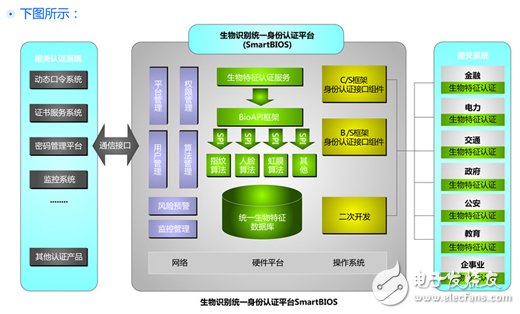What is iris recognition? If you ask someone in the past few years, maybe you don't know much about this new concept, but with the rapid development of mobile Internet in recent years, technology is changing with each passing day, and iris recognition technology has been obtained in various fields of safety. widely used. Such as smart phones, PC tablets, car infotainment, smart security and smart home. Although the iris recognition technology is a new word, in fact, as early as 2015, the technology has been applied to the Fujitsu Volkswagen mobile phone in Japan. Later, due to various reasons, it has not been widely spread. Most people just stay in "know." On the technical level. So, now I want to ask more, what is iris recognition?
What is iris recognition technology?
In normal life, what we mean by iris is the muscle that regulates the size of the pupil outside the eye and controls the amount of light entering the eye. It is the colored part of the eye based on the amount of melatonin. Iris recognition technology is to identify the identity of the human eye by capturing the iris of the human eye. It is a biometric-based identity authentication technology, also known as biosecurity technology.
The earliest theory of iris recognition began in the 1930s, but the real commercialization of technology was after the 1990s. Dr. John Dargman of Cambridge University, who is the pioneer of iris recognition in the industry, is the first person to truly implement iris recognition technology from theory.
Iris recognition technology is simply a safety detection technique based on the iris in the eye for identification. Technically speaking, the iris pattern is scanned and imaged by a near-infrared light, and the degree of similarity is determined by the XOR operation of the pattern pixel bits.
The iris recognition process first needs to separate the iris from the eye image and then perform feature analysis.
Principle of iris recognition technology
In general, the process of iris recognition technology mainly has four processes, namely iris image acquisition, image preprocessing, feature extraction and feature matching. The following details are detailed:
·Iris image acquisition refers to shooting the entire eye of a person using a specific digital camera device, and transmitting the captured image to a computer through an image capture card for storage;
Image pre-processing means that since the captured eye image includes a lot of redundant information and cannot meet the requirements in terms of sharpness and the like, it is necessary to perform pre-processing operations including image smoothing, edge detection, image separation, and the like;
· Feature extraction refers to extracting unique feature points from the separated iris images by a certain algorithm and encoding them;
Finally, feature matching refers to matching and verifying according to the feature code and the iris image feature code stored in the database in advance, so as to achieve the purpose of recognition.
Prior to the iris recognition process, technical implementation required imaging of the iris of the human iris, and imaging, feature separation and extraction of the iris using these features and specific shapes. Based on iris imaging, two-dimensional Gabor waves are screened and plotted as phasors. The phasor information includes direction and spatial frequency (image content) and image position. Using these phasor information, it is drawn as “iris codeâ€, and finally the iris code is used. Certify.
Here is a brief introduction to two broad iris recognition detection and certification technologies.1. Ultra-thin thin iris recognition system based on OSRAM Semiconductor SFH 4786S infrared LED

OSRAM's new SFH 4786S IRED has a depth of 1.6 mm, which is one-third thinner than the previous version of the SFH4780S. Its own light exit direction is slightly inclined, so there is no need to add any mechanical assistance to adjust the light direction.
As the most reliable and safe identification technology, iris recognition has been widely used in smart devices such as smartphones and tablet PCs in recent years. In 2014, Osram introduced the first IRED that integrates compact, highly reliable iris recognition into mobile devices. The 2.4mm high SFH 4780S is sufficient for maximum light extraction efficiency, while the SFH 4786S is reduced to a height of 1.6 mm to meet the design requirements of lower height ultra-thin transmitters.
The SFH 4786S has a new feature, that is, the launch direction is tilted by 8°. For the original distance camera, the tilt of 8° is more open for the field of view, making the performance of the entire system significantly better than that of a vertically upward-emitting transmitter. The system, and most of the iris recognition systems so far, mechanically slanted the IRED slightly. With the SFH 4786S, these additional materials and installation costs can be drastically reduced, and the complexity of the iris scanner design is greatly reduced for the customer.
In addition, the application benefits from the slightly widened emission angle of the IRED (+/-13°), which allows the mobile device's built-in iris scanner to illuminate larger areas at normal working distances, and the illuminated area is brighter. Evenly. At a current of 1 A, the typical radiant intensity of the SFH 4786S is 1.750 mW/sr.
2, Tiancheng Shengye SmartBIOS cross-platform open, scalable biometric authentication

Tiancheng Shengye launched the SmartBIOS identity unified authentication biometric platform based on fingerprint, face and iris and other biometric identification technologies to establish a cross-platform, open and scalable unified identity authentication platform to realize user identity. Safe, convenient, authentic and accurate certification, suitable for security risk prevention of computer network application systems in various fields.
The SmartBIOS authentication platform is based on the SOA architecture and supports both C/S and B/S application modes. It mainly includes: system management, biometrics authentication, biometric database, authentication interface component and other components. It is a relatively independent development and operation platform based on open software and hardware.
The authentication platform is characterized by scalability and flexible deployment. It provides biometric authentication interface and management interface to support the access of multiple computer network application systems, and provides users with centralized and unified biometric identity authentication services.
The overall architecture of the platform consists of five parts: database, system management, core services, system interfaces, and associated systems.
The SmartBIOS platform can provide a C/S architecture or a B/S architecture interface to provide a unified, centralized biometric authentication service for multiple applications of a standard interface. At the same time, it supports cluster technology, which can achieve dynamic load balancing and excellent concurrent processing capability.
SmartBIOS also supports comprehensive fingerprint, iris, face device and algorithm support, and important data is encrypted through communication and storage, and the device is verified for legality, and the device is more secure.
Rice Mill Tractor,Ostad Rice Huller,Rice Mill Rubber Roller,Rice Huller
HuangShi Stee Metal Material Technology Exploitation Co.,Ltd , https://www.wosenstechnology.com
![<?echo $_SERVER['SERVER_NAME'];?>](/template/twentyseventeen/skin/images/header.jpg)